Some of the features and functions described in this article are limited by P2ANav user role.
Overview
Subscriptions are associated with Companies in P2ANav. If users are members of multiple companies (i.e. a production, live company and a sandbox company for testing) they will see navigation elements that allow them to navigate between companies.
Key User Interface Elements
List of Companies
- There are 2 ways to change companies. Users can use the Company selector at the top of the page or the Change Company link in the main navigation side panel.
 The Company selector at the top of the page.
The Company selector at the top of the page.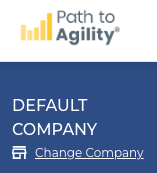 The Change Company link in the navigation side panel.
The Change Company link in the navigation side panel.
Company Dashboard
Once a company is selected, users will see the company dashboard. Currently, the company dashboard shows the assessment progress across all the organizations in that company. Users can drill down into specific organizations by clicking the "Open Org" link.
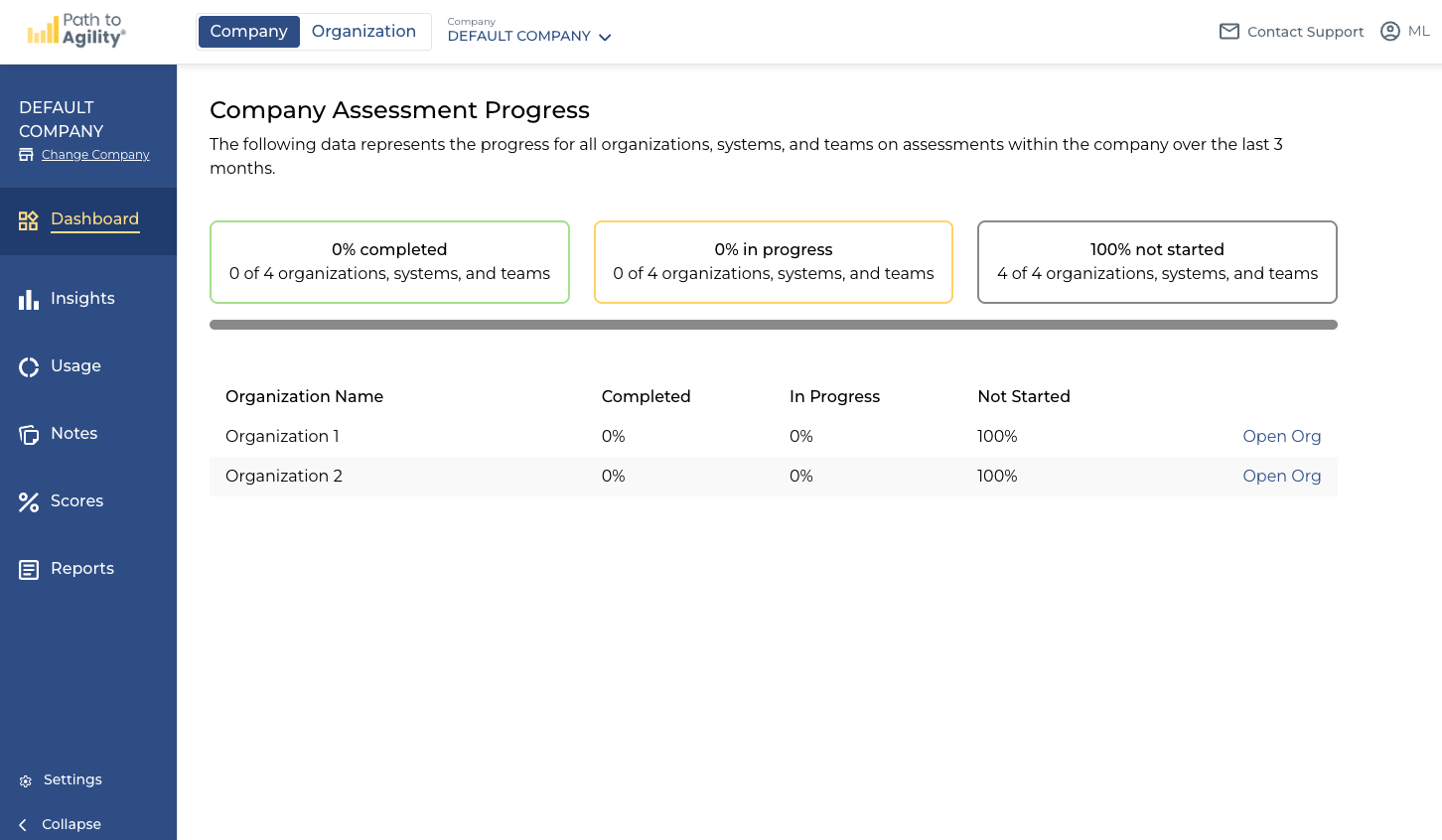 Company Dashboard reflecting the assessment progress across all organizations.
Company Dashboard reflecting the assessment progress across all organizations.Visit Navigating to Your Organization for more information about selecting an organization from this page.
Company Settings
In the bottom left of the main navigation, users can access the administrative functions for a company by clicking on Settings. Whether this link is accessible and the options available depend on the user's role.
 Administrative functions available under Company Settings.
Administrative functions available under Company Settings.Manage Hierarchy
Manage Hierarchy allows administrative users to manage the company hierarchy. This is a fundamental step as it's where users create the organizational structures that make up their company. Only Company Administrators have the ability to manage the company hierarchy. If you do not have this ability and believe you should, please reach out to your admin team.
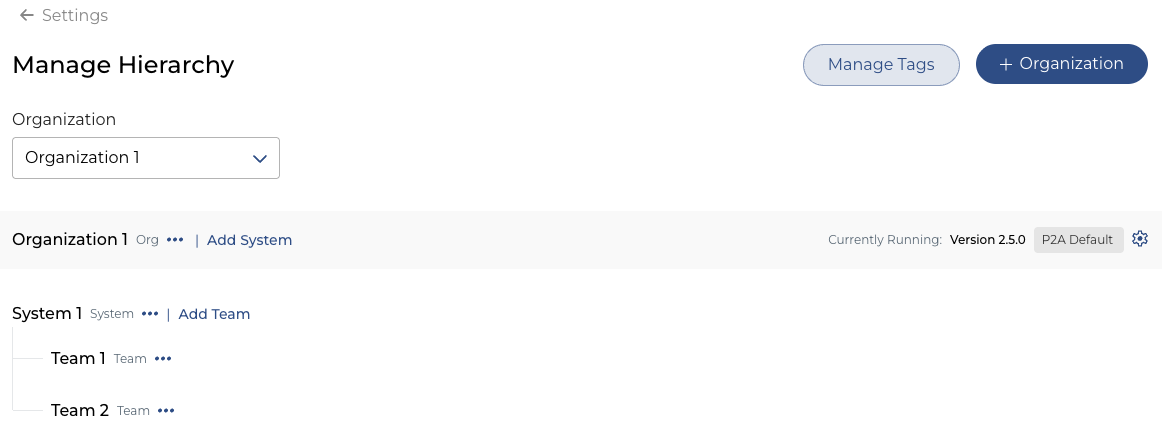 The Manage Hierarchy administrative page.
The Manage Hierarchy administrative page.Before going into more details on the hierarchy functions, the Manage Hierarchy page also supports setting the P2A version for individual organizations.
 The P2A version can be set for each organization. The version will be set to the default automatically.
The P2A version can be set for each organization. The version will be set to the default automatically.
By clicking the gear icon beside the version information, the version can be set for the current organization. Currently there are two different versions available. When the modal appears (by clicking the gear icon), select the desired version and click Confirm. This will update the descriptions and acceptance criteria for the capabilities to use the version selected.
- The default of baseline version
- A Scaled Agile Framework (SAFe®) version
 Modal that can be accessed by clicking the gear icon by the version. This customizes the P2A version for an organization.
Modal that can be accessed by clicking the gear icon by the version. This customizes the P2A version for an organization.Now let's return to the primary focus of the page, which is management of the business units and the hierarchy itself.
- There are three distinct levels as defined and supported by the Path to Agility
- Organizations - top-level representing leadership, culture, strategy, etc.
- Systems - cross-team work, value of delivery, scaling, etc.
- Teams - individual teams where work gets done
- The setup screen allows you to create, rename, archive, and delete business units (organizations, systems, and teams)
- Users also have the ability to move systems and teams (organizations are the highest level and cannot be moved)
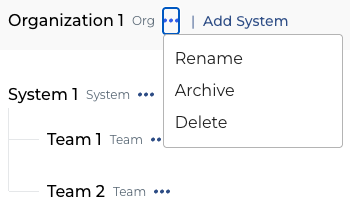 Management options for existing business units can be accessed by clicking the 3-dot menus. New business units can be created using the Add options.
Management options for existing business units can be accessed by clicking the 3-dot menus. New business units can be created using the Add options.
- Details about the supported functions for hierarchy elements
- Rename: Enables users to update the name of a business unit
- Move: (systems and teams only): Move to a different location, eg. org or system. You can optionally choose to copy. When you move a system/team you have an option to move all assessment data, keep all assessment data where it currently is, or move only the unpublished assessment data (shown below). This feature therefore enables you to move a system or team without changing any of your baseline data.

- Delete: Can not be undone! Removes all associated data.
- Archive: Archive retains the historical data while removing the business unit from the default navigation. Essentially, an archived business unit and its data is still accessible but will be excluded from actions by default. Note: Archiving an organization or system business unit will archive any associated child nodes (i.e. archiving a system will also archive any associated teams).
- Filters where business units are listed for selection (i.e. reports) provide the option to include/exclude data from archived nodes in the results
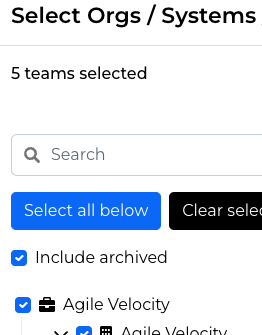 Checkbox allowing archived business units to be included or excluded from the listing or results.
Checkbox allowing archived business units to be included or excluded from the listing or results.
- Filters where business units are listed for selection (i.e. reports) provide the option to include/exclude data from archived nodes in the results
For larger enterprises exploring additional ways to segment their team hierarchy, our Team Tagging may be of interest.
Manage Users
From the Company Settings, click the Manage Users
- You can then add and import users.
- Add one at a time: You'll need user names and email addresses.
- The default selection for new users is Basic User, but the role they will be assigned may be changed using the Role dropdown
- Import: Upload a .csv file
- Fields: Full Name, Email address
- Imported users will be assigned Basic User
- Add one at a time: You'll need user names and email addresses.
New users will receive an automatic email invitation from hello@p2anav.com. The subject line will be "Welcome to Path to Agility Navigator!" The email will have a link for the user to complete setup, including setting their password
- From the user screen, you can also access:

- Resend a welcome email
- View user log: Shows details by action, types, description and date
- Change user role
- View Only: Can see all data but cannot run polls, publish assessments, delete assessments, or administer users.
- Basic User: Can see all data and run polls, but not publish assessments, delete assessments, or administer users.
- Assessment Admin: Can see all data, run polls, publish assessments, and delete assessments, but not administer users.
- Company Admin: Can see all data, administer assessments, and administer users.
- View Only: Can see all data but cannot run polls, publish assessments, delete assessments, or administer users.
- Delete user: Cannot be undone.
It is not currently possible to edit a user's name or email address. To make changes or corrections, delete the existing user and add a new one to replace them.
Customize Language
If available, the Path to Agility language can be manually tailored to better fit your company's needs. If you're interested in this feature, reach out to support@pathtoagility.com to learn more.

Agile Outcome descriptions, Agile Capability descriptions, and Agile Capability acceptance criteria can be changed. Find the entry you would like to customize, and double click into the "Custom Description" or "Custom Acceptance Criteria" field to write in your new value.
If you'd like to clear the customization, simply clear out the contents of the field.
Export Data as CSV
All assessment data for the entire company can be exported to a CSV file using this option.






